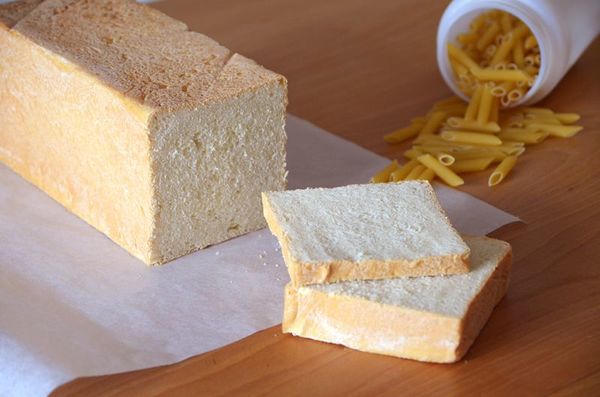Sliced bread made "from recycling"
byIbán Yarza (lamemoriadelpan.com, tequedasacenar.com)
Leftovers, scraps, "apurrak", as the Basques say, it's amazing what we leave, and frequently throw away, not knowing what to do with it. Recycling is a relatively modern word for designating something which has been done since cooking began: making the most of leftovers, i.e. never throwing anything away. This bread is a perfect example and has been created, in particular, with the catering sector in mind, where it's not unusual to always find a few leftovers from the most varied preparations. In this case, leftover pasta (this could refer to boiled and drained macaroni) is a perfect example of the unexpected use of many foods which always languish at the back of the fridge. Cooked pasta, just like almost any other starchy product or cereal leftover (semolina, oat flakes, potato, even cooked legumes), is a great extra in the preparation of dough, lending it juiciness, sweetness, preservation properties and good browning features.

All of the above are features which are highly desirable for sandwich bread, hence this being the bread type we recommend, however a round loaf could also be made. All you have to do is to reduce the selected ingredient to purée (cooked pasta in this case) until obtaining a sweet pudding texture full of starches which are ideal for fermentation. If we use up to 20% of the recycling ingredient in proportion to the weight of the flour, no one will find anything strange, just good things! Nevertheless, a larger quantity could be added although, in that case, the ingredient may play a more leading role (which can be very interesting). The addition of a little ferment (a sponge in this case) gives the bread a delicate depth of flavour, in addition to giving it preservation properties and volume.
For the ferment
- Bread flour 125 g
- Water 75 g
- Yeast 1 g
For the dough
- Ferment
- Bread flour 1000 g
- Cooked pasta 200 g (in this case cooked and drained macaroni)
- Water for making the pasta purée 200 g
- Butter 100 g
- Sugar 50 g
- Whole milk 300 g
- Water 50 - 100 g
- Salt 20 g
- Yeast 20 g
In order to prepare the ferment, the ingredients are mixed and left to stand for 5 hours at ambient temperature, or for one hour at ambient temperature and all night in the fridge.
Once the ferment is ready, the pasta purée is prepared. The pasta, with its water (the same quantity), is put through the food processor or blender until a smooth purée is obtained similar to a béchamel sauce. Finally, all the ingredients are added to the kneader, including the ferment and the pasta purée. It is kneaded for 3 minutes at the lowest speed and a further 7 to 9 minutes until the dough is smooth. The resulting dough should be pliable and silky. Add water if required.
Ferment for 2 hours at ambient temperature, shape into bars by rolling the dough fairly firmly and place in greased baking dishes. Ferment for a further 2 and a half hours or 3 until the mixture clearly rises to the surface of the baking dish. Brush with milk or cream prior to placing in the oven and bake at 200ºC for approximately 40 minutes for 600 g portions (increase the time according to the size) with moisture inside the oven throughout the entire baking process. Remove from the baking dish once ready and leave to cool on a wire rack before cutting.
